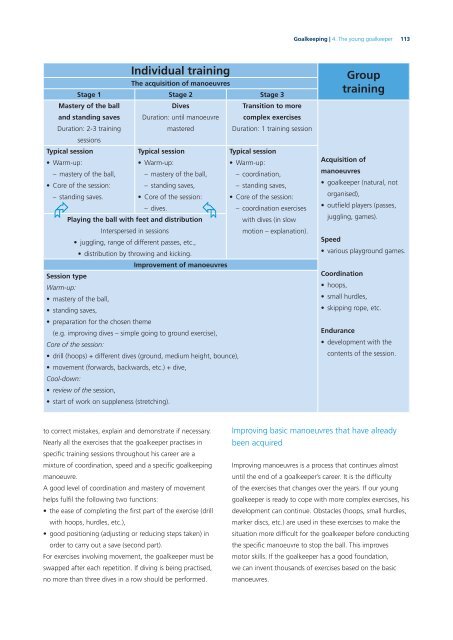Goalkeeping-bok
Goalkeeping-bok
Goalkeeping-bok
You also want an ePaper? Increase the reach of your titles
YUMPU automatically turns print PDFs into web optimized ePapers that Google loves.
<strong>Goalkeeping</strong> | 4. The young goalkeeper<br />
Individual training Group<br />
The acquisition of manoeuvres<br />
training<br />
Stage 1 Stage 2 Stage 3<br />
Mastery of the ball<br />
Dives<br />
Transition to more<br />
and standing saves Duration: until manoeuvre complex exercises<br />
Duration: 2-3 training<br />
sessions<br />
mastered<br />
Duration: 1 training session<br />
Typical session<br />
• Warm-up:<br />
Typical session<br />
• Warm-up:<br />
Typical session<br />
• Warm-up:<br />
– mastery of the ball, – mastery of the ball, – coordination,<br />
• Core of the session: – standing saves,<br />
– standing saves,<br />
– standing saves.<br />
• Core of the session:<br />
– dives.<br />
<br />
Playing the ball with feet and distribution<br />
• Core of the session:<br />
– coordination exercises<br />
with dives (in slow<br />
Interspersed in sessions<br />
• juggling, range of different passes, etc.,<br />
• distribution by throwing and kicking.<br />
Improvement of manoeuvres<br />
Session type<br />
Warm-up:<br />
• mastery of the ball,<br />
• standing saves,<br />
• preparation for the chosen theme<br />
(e.g. improving dives – simple going to ground exercise),<br />
Core of the session:<br />
motion – explanation).<br />
• drill (hoops) + different dives (ground, medium height, bounce),<br />
• movement (forwards, backwards, etc.) + dive,<br />
Cool-down:<br />
• review of the session,<br />
• start of work on suppleness (stretching).<br />
to correct mistakes, explain and demonstrate if necessary.<br />
Nearly all the exercises that the goalkeeper practises in<br />
specifi c training sessions throughout his career are a<br />
mixture of coordination, speed and a specifi c goalkeeping<br />
manoeuvre.<br />
A good level of coordination and mastery of movement<br />
helps fulfi l the following two functions:<br />
• the ease of completing the fi rst part of the exercise (drill<br />
with hoops, hurdles, etc.),<br />
• good positioning (adjusting or reducing steps taken) in<br />
order to carry out a save (second part).<br />
For exercises involving movement, the goalkeeper must be<br />
swapped after each repetition. If diving is being practised,<br />
no more than three dives in a row should be performed.<br />
Acquisition of<br />
manoeuvres<br />
• goalkeeper (natural, not<br />
organised),<br />
• outfi eld players (passes,<br />
juggling, games).<br />
113<br />
Speed<br />
• various playground games.<br />
Coordination<br />
• hoops,<br />
• small hurdles,<br />
• skipping rope, etc.<br />
Endurance<br />
• development with the<br />
contents of the session.<br />
Improving basic manoeuvres that have already<br />
been acquired<br />
Improving manoeuvres is a process that continues almost<br />
until the end of a goalkeeper’s career. It is the diffi culty<br />
of the exercises that changes over the years. If our young<br />
goalkeeper is ready to cope with more complex exercises, his<br />
development can continue. Obstacles (hoops, small hurdles,<br />
marker discs, etc.) are used in these exercises to make the<br />
situation more diffi cult for the goalkeeper before conducting<br />
the specifi c manoeuvre to stop the ball. This improves<br />
motor skills. If the goalkeeper has a good foundation,<br />
we can invent thousands of exercises based on the basic<br />
manoeuvres.


